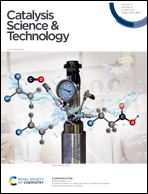Tailorable boron-doped carbon nanotubes as high-efficiency counter electrodes for quantum dot sensitized solar cells†
Abstract
Doping of specific boron species in carbon frameworks plays an important role in enhancing the electrochemical properties of carbon. Herein, we prepared a tailored boron species-doped carbon nanotube (CNT) catalyst as the counter electrode (CE) of quantum dot sensitized solar cells (QDSSCs) by hydrothermal post-treatment of pre-oxidized CNTs. X-ray photoemission spectroscopy results show that boron is mainly present as oxygen-containing (C–O–B) and oxygen-free (C–B) boron in the sp2 carbon framework, so different levels of pre-oxidation treatments can control the content of oxygen-containing boron species and thus achieve controlled doping of boron species. Electrochemical impedance spectroscopy shows that the optimized boron-doped CNTs (BCNT1) obtained a charge transfer resistance (Rct) as low as 2.17 Ω, indicating excellent reduction activity to Sn2− at the CE/electrolyte interface. The QDSSC based on the BCNT1 CE and CdS/CdSe photoanode achieves a power conversion efficiency of up to 4.55%, which is 3.10 times that of the pristine CNT CE. Our report confirms that tailorable boron doping is an effective strategy to enhance the activity of CNTs for Sn2− reduction.



 Please wait while we load your content...
Please wait while we load your content...